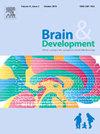The correlation of intracranial parenchymal calcium score and the severity of neurological clinical presentation in carbonic anhydrase deficiency type 2
IF 1.4
4区 医学
Q4 CLINICAL NEUROLOGY
引用次数: 0
Abstract
Background
Carbonic anhydrase type II deficiency (CAII-D) syndrome is a rare autosomal recessive genetic disorder characterized by osteopetrosis, renal tubular acidosis, and brain calcifications. Understanding the clinical and radiological features of CAII-D is key to effective management.
Aim
This study aimed to comprehensively analyze and measure intracranial parenchymal calcium score in pediatric CAII-D in relation to the severity of neurological clinical presentation.
Methods
A retrospective chart review at King Saud University Medical City included pediatric CAII-D patients diagnosed between June 2015 and December 2022. Study variables included age, gender, genetic results, developmental status, developmental quotient (DQ), CT findings, optic canal diameter, intracranial calcium score, and neuropsychiatric symptoms.
Results
Ten CAII-D patients, median age 10.5 years, were included. Most patients displayed homozygous pathogenic CA2 gene variants. For neurodevelopmental symptoms, 60.0 % of patients presented with global developmental delay, 20.0 % had intellectual disability, and the remaining 20.0 % had normal development. The median DQ score was 63.50, with 80.0 % categorized as delayed. Neuropsychiatric disorders were present in 20.0 %. Optic nerve atrophy was observed in 22.2 %, while brain calcifications were present in 70.0 % of cases. Correlation analysis revealed no significant associations between intracranial parenchymal calcium score and age, DQ score, or optic canal diameter. Neurodevelopmental symptoms, neuropsychiatric symptoms, and DQ were not associated with intracranial parenchymal calcium score.
Conclusion
Intraparenchymal calcifications in CAII-D are common but unrelated to developmental delay and neuropsychiatric symptoms, suggesting complex pathophysiology. Follow-up brain imaging may not aid in prognosis or severity assessment, highlighting the need for further research.

碳酸酐酶缺乏症2型患者脑实质钙评分与神经学临床表现严重程度的相关性。
背景:碳酸酐酶II型缺乏症(CAII-D)是一种罕见的常染色体隐性遗传病,以骨质疏松、肾小管酸中毒和脑钙化为特征。了解CAII-D的临床和影像学特征是有效治疗的关键。目的:本研究旨在综合分析和测量小儿CAII-D颅内实质钙评分与神经学临床表现严重程度的关系。方法:回顾性回顾沙特国王大学医学城2015年6月至2022年12月诊断的儿科CAII-D患者。研究变量包括年龄、性别、遗传结果、发育状态、发育商(DQ)、CT表现、视管直径、颅内钙评分和神经精神症状。结果:纳入10例CAII-D患者,中位年龄10.5岁。大多数患者显示纯合子致病性CA2基因变异。对于神经发育症状,60.0%的患者表现为整体发育迟缓,20.0%为智力障碍,其余20.0%发育正常。DQ得分中位数为63.50,其中80.0%被归类为延迟。20.0%存在神经精神障碍。视神经萎缩占22.2%,脑钙化占70.0%。相关分析显示颅内实质钙评分与年龄、DQ评分或视神经管直径无显著相关性。神经发育症状、神经精神症状和DQ与颅内实质钙评分无相关性。结论:cai - d的实质内钙化是常见的,但与发育迟缓和神经精神症状无关,提示复杂的病理生理。随访脑成像可能不能帮助预后或严重程度评估,强调需要进一步研究。
本文章由计算机程序翻译,如有差异,请以英文原文为准。
求助全文
约1分钟内获得全文
求助全文
来源期刊

Brain & Development
医学-临床神经学
CiteScore
3.60
自引率
0.00%
发文量
153
审稿时长
50 days
期刊介绍:
Brain and Development (ISSN 0387-7604) is the Official Journal of the Japanese Society of Child Neurology, and is aimed to promote clinical child neurology and developmental neuroscience.
The journal is devoted to publishing Review Articles, Full Length Original Papers, Case Reports and Letters to the Editor in the field of Child Neurology and related sciences. Proceedings of meetings, and professional announcements will be published at the Editor''s discretion. Letters concerning articles published in Brain and Development and other relevant issues are also welcome.
 求助内容:
求助内容: 应助结果提醒方式:
应助结果提醒方式:


